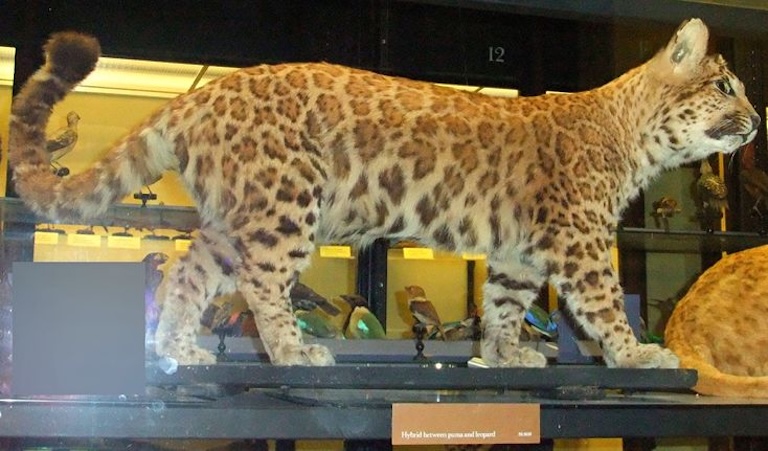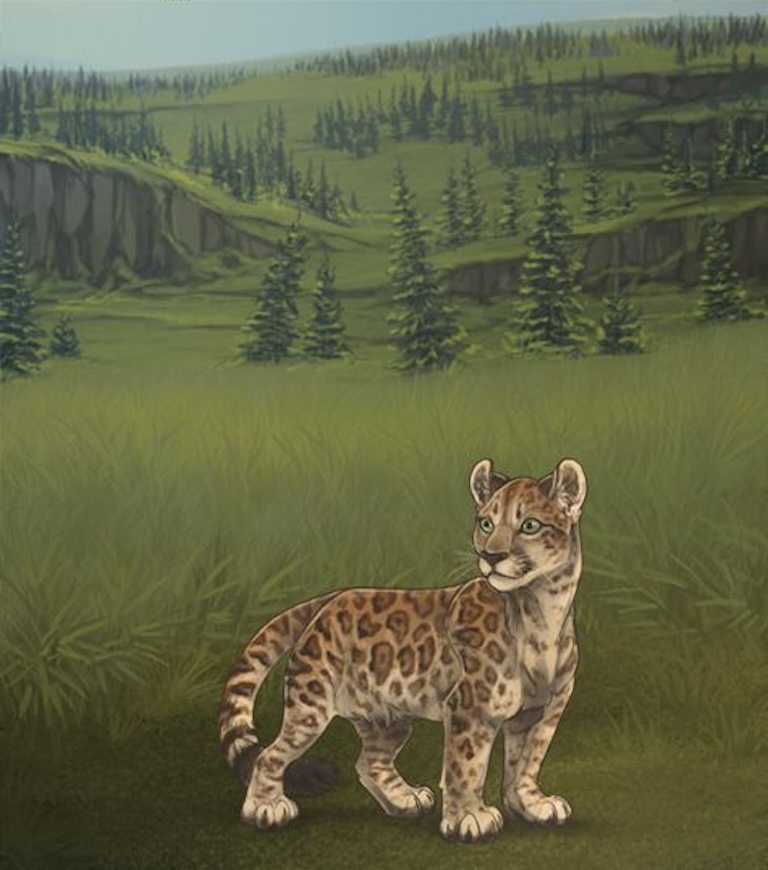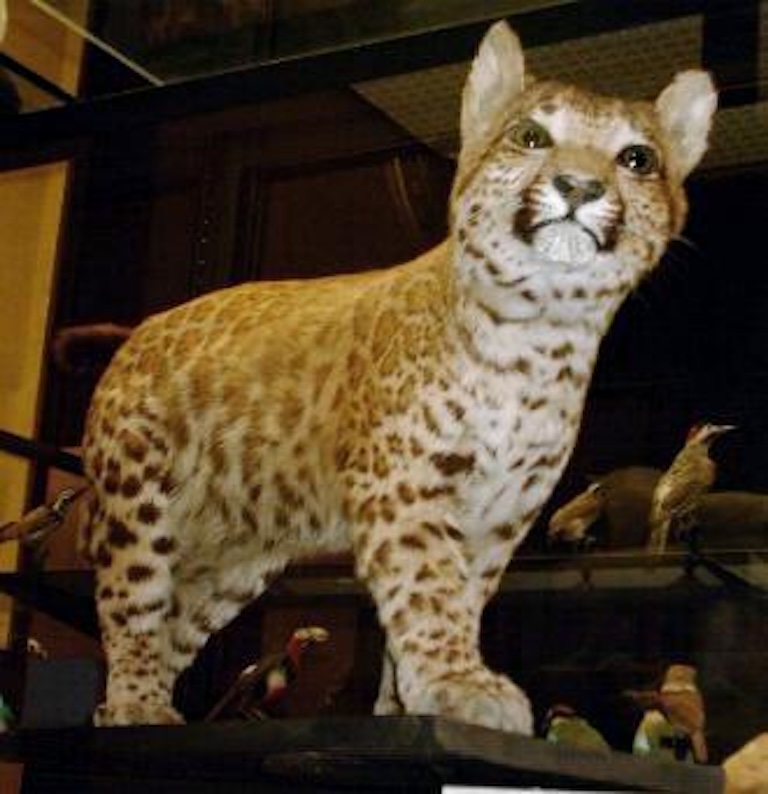Pumapard Profile
Humans have a bit of a murky history of breeding unrelated species together just to see what comes out. Today’s adorable abomination is the pumapard, the unholy spawn of a North American puma and a leopard.
Sadly, it’s not as awesome as it sounds.

Pumapard Facts Overview
| Habitat: | Domestic, zoos |
| Location: | Worldwide |
| Lifespan: | Unknown |
| Size: | Around 2.7m (9 feet) including tail |
| Weight: | Unknown |
| Colour: | Sandy, tawny coat with faded spots |
| Diet: | Carnivore |
| Predators: | None |
| Top Speed: | Unknown |
| No. of Species: | Hybrid between 2 species |
| Conservation Status: | N/A |
This is a cat that should never have been, but unfortunately, it was. And while it didn’t kick off with the public, it did gather some attention from the scientific community.
Pumas and leopards are so far from one another on the evolutionary tree, they shouldn’t be able to reproduce. The fact that they can, shows us that genetics are more flexible than we thought, but the failure rate and poor health of the ‘successes’ also demonstrate there’s a limit to how far they can be pushed.
Interesting Pumapard Facts
1. They’re unusual, even for hybrids
Big cats are well known to hybridise into strange, sickly giants like Napoleon Dynamite’s favourite, the [Liger], and the similarly-conceived [Tigon].
Leopards, lions and jaguars are also fairly known to produce offspring between one another when under duress, and these are often a mix of both parents’ physical attributes in various proportions and a bunch of deleterious artefacts from poor genetic matchings.
But all of these species are in the same genus, Panthera. What makes Pumpards even more unusual is the particularly long evolutionary gap between the mating parents.
Cats branched off from a common ancestor with hyenas and mongooses around 15 million years ago, after which Puma emerged around 11.5 million years ago, splitting from the ancestor of Panthera entirely and going off to do its own thing.
Unlike lions and tigers, who diverged around 5 million years ago, leopards and pumas weren’t even on evolutionary speaking terms for more than twice that, so the fact that they can come together and make babies is pretty remarkable.
To put this in perspective, humans and chimps shared a common ancestor only 5-7 million years ago.
But just because they could, doesn’t mean they should. 1

2. This didn’t happen by accident
The first known pumapard was reportedly bred by an American in the late 1800s in Chicago.
He intentionally crossed a male puma with a female leopard in captivity as a zookeeper. This mating resulted in the birth of the first known pumapard.
The breeding of pumapards continued in Germany, where most didn’t survive, and aside from the high failure rate of such a genetic abnormality, they were a short-lived curiosity. 2
3. The three were bought for around £90
In 1898, a second breeder bought a 9-month-old female puma-leopard cub from a menagerie in Britain for 26 guineas, along with its parents.
This amounts to something between £15,000 and £16,000 when adjusted for inflation and shows how optimistic the breeders were that this weird mix would be a hit. But the public wasn’t all that impressed. 3
4. They often have dwarfism
This is actually a common result of inappropriate breeding programs, especially ones that involve cross-breeding different species.
It’s also a very common side effect of breeding two animals who are too closely related, as described in the Amish community in the region of Pennsylvania’s Lancaster County, incidentally around a town called Intercourse.
In pumapards, being the result of barely-compatible species, dwarfism is rife, and they’re always smaller than both the father and the mother.
They’re also expected to live a lot shorter lives than their parents and are generally less fit for purpose of a wild cat. So, it’s hardly surprising, then, that this particular configuration of cat genes results in an animal with a reputation for being pissed off. 4
5. They have short-person syndrome
Early descriptions of the pumapards’ temperament by those who either bred them or received them are rife with – frankly, unreasonable – complaints.
Joseph Ferari, the owner of a wild animal show in 1906, succeeded in breeding a pair of pumpapards but didn’t much like their attitude.
They were said to have torn into their handler, spat and snarled at their photographer, and acted more or less as you’d expect a cat to act under the circumstances.
The handler commented, “They are in a fair way to make the ugliest and most treacherous beast in or out of captivity… Never have I seen the vicious element in animals developed so young”.
At 9 weeks, the pumpard was reviewed as the “nastiest animal of his age I ever saw.. an all-round-bad-egg.

6. They weren’t all that popular
As a result of their justifiable outrage, and on account of their pelts being a sort of dimmed version of a leopard’s, they were quickly declared “dull and uninteresting” by the papers. In 1951, a male cub was bred in captivity, and reared by a fox terrier in Hamburg.
It was said to have a puma-coloured coat with faint leopard spots. While it had a long tail, it was a small animal and generally underwhelming.
In contrast, the scientific community find this hybrid a lot more captivating.
Modern genetics would have dictated that the leopard and the puma were not closely enough related to produce offspring, so the very existence of the pumapard does humble the scientific community somewhat and opens up new questions about whether we could breed a new race of people with the intricate finger dexterity of a modern human and the intelligence of an orangutan.
Pumapard Fact-File Summary
Scientific Classification
| Kingdom: | Animalia |
| Phylum: | Chordata |
| Class: | Mammalia |
| Order: | Carnivora |
| Family: | Felidae |
Fact Sources & References
- “Panthera”, Science Direct.
- “Pumapard”, Biolity.com.
- “Pumapard”, Messy Beast.
- (1964), “Medicine: Inbreeding & Dwarfism”, Time.
